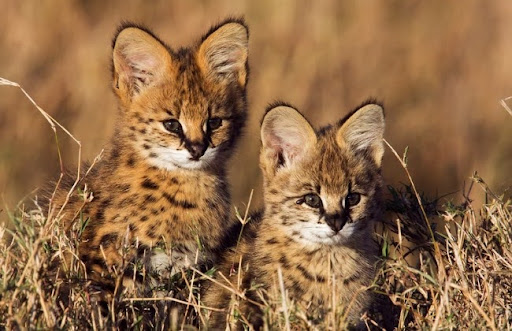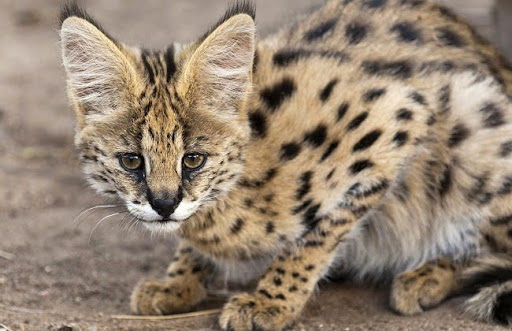Serval (Leptailurus serval) is a wild cat species native to Africa. It is the only member of the Leptailurus genus and was first described by the German naturalist Johann Christian Daniel von Schreber in 1776. Currently, 18 subspecies of serval are recognized. Let’s explore more about this mysterious wild cat through the following article.

Habitat and Natural Environment of the Serval
Servals primarily inhabit the southern regions of the Sahara Desert, with some scattered populations in northern Africa. Their main habitat is grasslands, although they can also be found in mountainous areas up to 3,000 meters in elevation. Due to their need for water within their territories, they avoid living in barren deserts or dry grasslands. They also steer clear of dense equatorial forests, although they may be spottedaong forest edges. The territorial range for females is approximately 9.5-19.8 square kilometers, and for males, it is 11.6-31.5 square kilometers.


Biological Characteristics and Behavior of the Serval
Servals have relatively long reproductive cycles, occurring from August to January in southern Africa and from April to June in northern Africa. Their gestation period is 66-77 days, and litters typically consist of 2-3 kittens, rarely 4. Kittens weigh about 250 grams at birth, open their eyes after 9-13 days, and nurse for 5-6 months. They start consuming meat at three weeks old and accompany their mothers on hunting trips at six weeks old. Kittens become independent and leave their mothers between 12-18 months old.
Servals’ lifespan in the wild is 10-12 years, while in captivity, it can reach 17-20 years. They produce a wide range of vocalizations, including growls, purrs, hisses, meows, chirps, and cries, often used for communication with other species or territorial marking.





Raising Servals: What You Need to Know and How to Care for Them
Servals are wild cats but can be raised in captivity and domesticated with proper care. However, raising servals is not easy due to their high space, dietary, health, and emotional needs. If you intend to raise servals, you should know the following:
Servals are expensive cats, priced from $4,000 to $10,000 each. You also need a permit to keep wild cats from the relevant authorities and comply with local safety and legal regulations.Servals need a spacious, airy, and safe living space. You need to build a large enclosure with enough room for them to run, jump, climb, and rest. The enclosure should also include toys, such as balls and ropes, to stimulate their intelligence and activity. Additionally, you should allow supervised outdoor access for them to interact with the natural environment and other animals.Servals are carnivores, so you need to provide them with a protein-rich and nutritious diet. You can feed them beef, chicken, rabbit, fish, mice, or specialized food for wild cats. You should also ensure they drink plenty of clean water andaoid feeding them foods containing sugar, starch, or preservatives.Servals need regular health care, including vaccinations, health checks, nail trimming, and cleaning of ears, eyes, and teeth. You should find a veterinarian experienced with wild cats and monitor any abnormal signs in their behavior, temperature, activity, and feces. If you notice signs of illness, you should take them to the vet immediately.Servals require affection and attention from humans. You need to spend time playing, petting, and talking to them every day to build a bond of trust and affection. You should also train them from a young age to adapt to indoor life and follow your rules. However, you should also respect their wild and independent nature and not force them to do things they dislike.


The Importance of Protecting and Conserving Servals in the Wild
Servals play a significant role in the ecosystem and biodiversity of Africa. They are one of the most efficient predator species, helping maintain the balance of animal species in nature. They also possess unique and beautiful characteristics, attracting the attention and affection of many people. Additionally, they have a vital role in the culture and history of many African communities, being seen as symbols of wisdom, creativity, and holiness.
However, servals face numerous threats and population declines due to factors such as habitat loss, illegal hunting, wildlife trafficking, and conflicts with humans. According to the International Union for Conservation of Nature (IUCN), servals are classified as a species vulnerable to endangerment, with an estimated population of only about 14,000 remaining in the wild. Without timely protection and conservation measures, servals may disappear from our planet in the near future.
Therefore, protecting and conserving servals in the wild is an important and urgent task for us. We need to take action now by:
Protecting and restoring serval habitats by minimizing human intervention in forest and grassland areas, planting trees, and creating reserves and national parks.Ending illegal hunting and wildlife trafficking by tightening management, control, and punishment of violations. We should also raise awareness and educate the community about the harmful effects of these activities on servals and wildlife in general.Minimizing conflicts between servals and humans by improving living conditions and economic opportunities for local people, encouraging them to use preventive and proper handling methods when conflicts arise, and supporting them in compensating for damages caused by servals.Promoting research and monitoring of servals by mobilizing resources and international cooperation, increasing the use of advanced technologies, and training professional conservationists and scientists.Respecting and conserving the cultural and historical values of servals by researching and documenting related myths, stories, and symbols, and encouraging the participation and contributions of local communities in protecting and conserving serv
